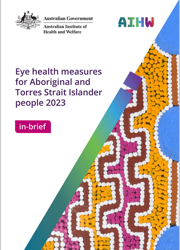Summary
This in-brief summarises the findings from the Eye health measures for Aboriginal and Torres Strait Islander people 2023 report and the accompanying web report. These reports bring together the latest available data on the 22 eye health measures for Aboriginal and Torres Strait Islander (First Nations) people with ongoing data collections (see the following table, ‘Eye health measures for Aboriginal and Torres Strait Islander people’).
The data for these measures provides information on:
- the prevalence and causes of vision loss and blindness
- detection and screening of eye diseases and vision problems
- eye health treatment services
- the eye health workforce and outreach and other programs.
During the reporting years, there have been notable improvements in the areas of:
- trachoma and trichiasis prevalence and screening in at-risk First Nations communities
- the percentage of community members treated in communities where active trachoma was identified
- annual health assessments for First Nations people and health assessments for First Nations people with an initial eye examination
- eye examinations by an eye health professional
- rates of screening for diabetic retinopathy
- hospitalisations for cataract surgery
- the number and full-time equivalent (FTE) rates of optometrists
- occasions of service provided under the Visiting Optometrists Scheme.
Waiting times for elective cataract surgery appear to have worsened as waiting times have increased.
The full report and online tables are available at Eye health measures for Aboriginal and Torres Strait Islander people 2023 and Eye health measures for Aboriginal and Torres Strait Islander people 2023: interactive data.
Introduction
- Eye health measures for Aboriginal and Torres Strait Islander people
1. How do eye health problems affect Indigenous Australians?
- How common is vision impairment and blindness?
- Self-reported eye or sight problems
2. How are eye health problems identified?
- Health assessments for First Nations people
- Health assessments for First Nation people and initial eye examination by an optometrist
- Eye examinations
- Eye examinations among target population
3. How are eye health problems treated?
- Hospitalisations for diseases and injuries of the eye
- Hospitalisations for eye procedures
- Cataract surgery
- Treatment for diabetic retinopathy
- Subsidised spectacles
- Impacts of COVID-19
4. Trachoma and trichiasis
- How common is trachoma?
- Trachoma screening and treatment
- Trachoma-related trichiasis
5. What is the size and location of the eye health workforce?
- Optometrists
- Ophthalmologists
6. What support is provided through outreach and other programs?
- Services provided
End matter: References



